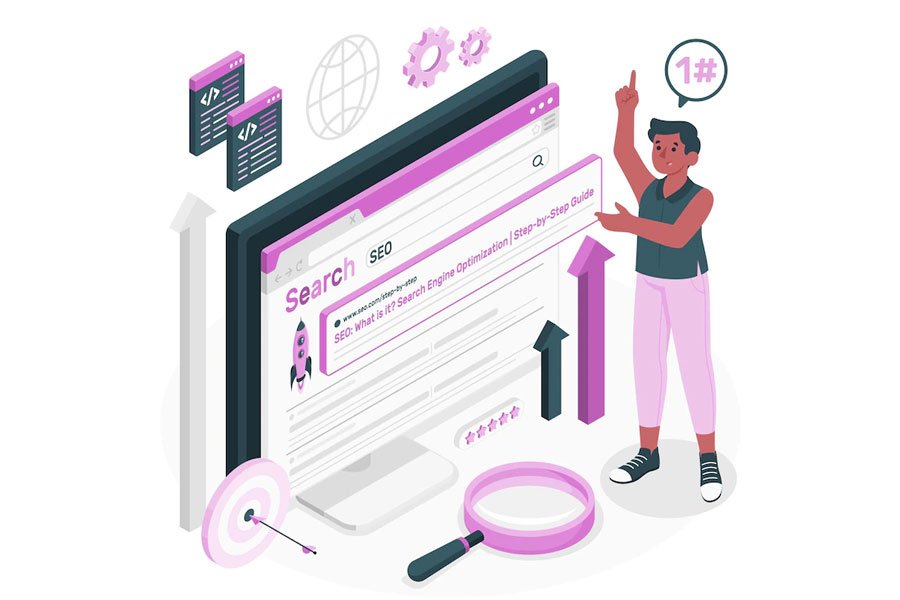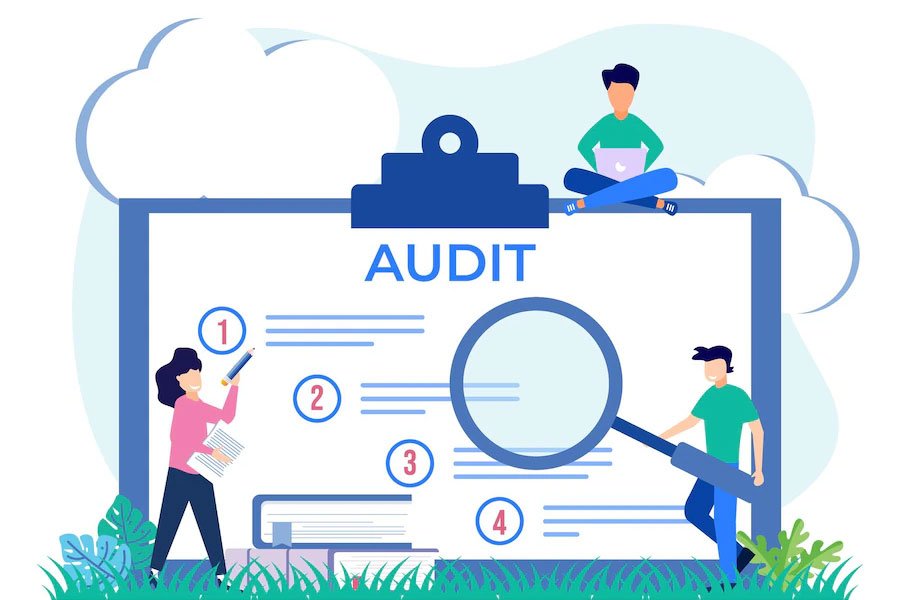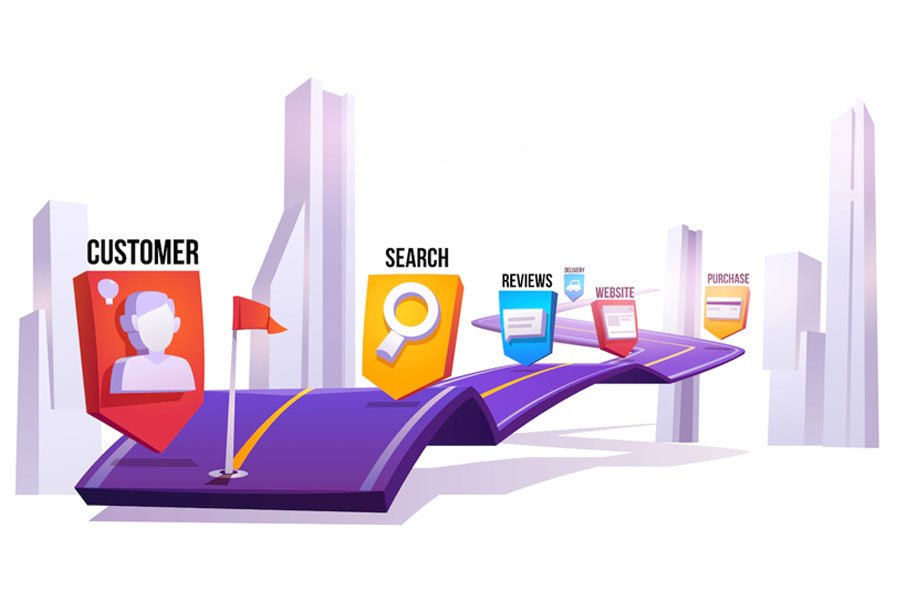Content Auditing: The Key to Unlocking Your Website’s Full Potential
Introduction

Did you know that users take only 0.05 seconds to form an opinion about a website? This opinion determines whether they continue to browse or leave the site and influences their inclination towards liking or disliking it. Moreover, 38% of users immediately stop engaging with a website if they find its content or layout unimpressive!
In today’s digital landscape, websites are the virtual front doors for brands, businesses and organisations. They are the primary touchpoints where customers and clients interact with a brand, gather information and make crucial decisions, shaping the brand’s image and driving conversions. However, amidst a multitude of websites striving for attention, simply creating a website for the sake of having an online presence won’t suffice to attract and retain the interest of your target audience.
To stand out in the highly-competitive and ever-evolving world of the internet, you need to have a fully optimised website that effectively engages your audience through high-quality, top-notch, relevant and up-to-date content. An underestimated yet essential and powerful technique to ensure that your website is performing at its best and meeting the needs and expectations of your audience is content auditing.
This blog will explore the importance and benefits of content audit for websites and the step-by-step content audit process to take your brand’s online presence, website content and SEO to new heights. Whether you’re a business owner or a content creator, this comprehensive guide will equip you with the tools and knowledge required to harness the power of content auditing to transform your website content marketing strategy, leave a lasting impression and drive impactful results.
What is a content audit?

Simply put, a content audit is a comprehensive and in-depth analysis of the content assets on your website. Content auditing, on the other hand, is a systematic process involving a detailed assessment of the quality, relevance and performance of your website’s existing content. The scope of a content audit covers written articles, blog posts, images, videos, infographics and all other forms of content on your website.
The key to maximising your website’s potential and streamlining its content, content quality audit helps you identify content gaps, inconsistencies and areas of improvement so that you can align your website content with your business goals and brand message to deliver an exceptional and memorable user experience.
Using valuable insights into what’s working and what’s not that you gain by conducting a thorough content audit, you can make informed decisions to strengthen your website’s search engine visibility, engagement factor and performance and ultimately convert your visitors into loyal customers. Essentially, a content audit enables you to refine your website content strategy, website content structure and website content format.
Why is a content audit important?

A content audit is pivotal in optimising your website and enhancing user experience. By reviewing and scrutinising your website’s existing content for quality and relevance, you can be mindful of what is published and refrain from publishing outdated, irrelevant or low-quality content that can damage your website’s performance, search engine rankings, credibility and user experience. Since 88% of online users are unlikely to revisit a website after an unfulfilling experience, your website must offer only valuable and up-to-date information to your visitors to be worthy of their time and attention. Such content will augment your SEO content writing efforts since search engines greatly favour websites with thoughtfully curated, latest and worthwhile content.
Conducting a content audit helps you identify content that needs to be updated, repurposed or eliminated from the website. By facilitating a better understanding of how well your existing content supports your goals, it empowers you to align your website content with your business objectives and the needs and expectations of your target audience, driving increased organic traffic, higher engagement rates and more chances of conversions.
Similar to content audit for social media, content auditing is the most reliable method to ensure and confirm that your website’s content is strategic, purposeful and consistent with your brand’s messaging, values and ethos. By uncovering the hidden opportunities for optimisation through a content audit, you can be proactive while managing your SEO content strategy so that your website stays relevant, resourceful and influential.
Benefits of conducting a content audit

Performing a content audit and making a content audit report offers numerous benefits that contribute to strategic content creation, your website’s overall success, your brand’s digital presence, and your Google brand profile. Let’s examine the key advantages of having a content audit template in place –
- Helps gain detailed and valuable insights into the website’s performance: Evaluating content metrics and engagement data while conducting a content audit will allow you to recognise and pinpoint the high-performing content pieces that substantially resonate with your audience and drive engagement. By analysing what sets these pieces apart and implementing those insights in content planning and optimisation, you can make informed decisions for future content creation to ensure content that augments overall performance, traffic and audience interaction.
- Helps deliver valuable content personalised for the target audience: By conducting a content audit, you’ll know exactly what type of content works for your target audience and what kind of content fails to impress them. So, by ensuring that your content strategy planning and SEO content ideas align with the needs, preferences, interests, pain points and expectations of your brand consumer profile, you will be able to create content that provides user satisfaction, boosts engagement, encourages return visits and strengthens your brand’s trust and credibility in the audience’s minds.
- Helps enhance content quality and user experience: A content audit bestows you with a comprehensive understanding of all the existing content on your website, enabling you to assess your content’s quality, relevance, organisation and accessibility from the perspective of your target audience. You can then leverage this knowledge to identify areas of improvement, address and fill content gaps, correct grammatical errors or formatting inconsistencies, eliminate outdated, irrelevant or low-quality content, streamline navigation and improve readability. A well-executed content audit is the first step to creating a user-friendly website with valuable and relevant content wherein visitors can find and access what they are looking for quickly and easily.
- Improves SEO performance and helps attract more organic traffic: Search engines invariably promote websites with high-quality and relevant content. Optimising your website content, headings, meta tags, internal links and keywords while addressing SEO issues like duplicate content or broken links through a content audit will generate a high-ranking website and an SEO blog strategy that translates to more organic traffic and opportunities for conversions.
- Helps achieve higher conversion rates: A content audit will help you apprehend the scope of improvement and areas of optimisation to accomplish your conversion and sales goals. Creating well-crafted and targeted content that resonates with the audience is the key to converting visitors into loyal customers.
- Helps refine your content strategy: One of the most noteworthy benefits of a content audit is that it aids in creating a data-driven content strategy template that includes content themes, formats and distribution channels. Acquiring an in-depth understanding of the content landscape, performance metrics, consumer behaviour, and market trends will guide your content strategy to align with the target audience, meet your business objectives, build a loyal following and position your brand personality profile as a reliable source of information and expertise.
- Helps streamline the content creation process and optimise costs by effective utilisation of resources: Through a content audit, you will be able to spot the specific pieces of content that need to be repurposed, updated, expanded upon, eliminated, reformatted, used as a foundation for new content or consolidated with other content pieces to provide valuable information in a cohesive and organised way to your users. A content audit allows you to leverage your existing resources quickly and efficiently to generate new content ideas and deliver fresh, high-quality content to fulfil your audience’s informational requirements.
A content audit will breathe new life into your website through a well-planned and strategic approach while saving time, money and resources.
Steps to perform a content audit

On the face of it, performing a content audit may seem daunting. After all, it necessitates a systemic approach, meticulous evaluation and informed decision-making to generate the desired results. The key to making the content auditing process more efficient and productive is breaking it down into manageable tasks. Here is a content audit checklist and a step-by-step guide to help you conduct a content audit effectively –
- Define the goals and objectives of the content audit: Before diving into the audit, clearly determine your goals and specify the desired outcomes you want to achieve. These objectives may include boosting SEO performance, improving user experience, enhancing engagement, driving conversions, identifying content gaps, finding new opportunities or aligning the content with your branding content strategy. Establishing the goals will guide your audit to focus on areas that may facilitate achieving them.
- Put together an inventory of all your website’s content: Create a comprehensive list of all the content on your website encompassing web pages, blogs, images, videos, downloadable assets etc. Categorise it as per type, topic, location and other relevant metrics. Use tools like Spreadsheets or dedicated inventory software to organise and categorise your content assets. Include URLs, titles, descriptions, publication dates, metadata, performance metrics and other relevant details. This inventory will provide a bird’s-eye view of the existing content on your website and serve as a foundation of your content audit.
- Evaluate content quality and relevance: Evaluate each piece of content from the inventory based on its quality, relevance to your target audience and alignment with your brand messaging and goals. Assign every piece a rating or score to track its performance and compare it with other content pieces. Incorporate the industry’s best practices, such as user feedback, comments, performance metrics, surveys and questionnaires, to consider the following factors:
- Currency: Is your content up-to-date?
- Accuracy: Is all the information presented on your website accurate, trustworthy and reliable?
- Readability: Does the formatting and organisation of the content make it easy to read, well-structured and engaging?
- Alignment with business goals: Does your content align with your business objectives?
- Alignment with the brand’s messaging and tone: Does your content align with your brand profiling?
- Freshness and usefulness: Does your content offer valuable information creatively and distinctly?
- Thoroughly analyse the content’s performance and engagement metrics: Use web analytics tools and SEO content tools like Google Analytics or Google Trends to review the key metrics such as page views, bounce rate, time on page and conversion rates and gather engagement data for each piece of content. Determine what type of content resonates with your audience and drives desired actions. Divide into different categories the high-performing content to leverage further and the underperforming content that must be removed, repurposed or updated. Look for patterns or trends that can guide your content strategy.

- Identify gaps and opportunities: Analyse your content inventory and the data collected to identify gaps in your content coverage and strategy and areas that need improvement. Look for opportunities to:
- Fill content gaps: Are there any topics or areas where your content is lacking or missing altogether? Address these gaps by creating new content that provides value to your audience and meets their expectations.
- Repurpose or update existing content: Are there any content pieces that can be repurposed or expanded upon to offer additional value to the visitors, target different audience segments, drive more organic traffic, increase conversions or boost engagement?
- Eliminate irrelevant content: Is there any outdated, irrelevant or low-performing content? Identify and remove such content to clear the clutter and improve user experience.
- Consolidate similar or redundant content: Are there multiple content pieces with similar topics or themes? Consider consolidating similar or repetitive content to streamline your website’s structure and enhance usability.
- Create a detailed action plan: Based on your analysis and audit findings, develop a clear and actionable plan outlining the necessary steps for content optimisation and improvement.
- Categorise each piece of content into one of the following actions: keep, update, repurpose, consolidate, or remove. The action plan must include what needs to be done for each of these categories as well as the creation of new content.
- Include the plan to improve metadata, internal linking or SEO efforts.
- Set clear goals, assign responsibilities and establish timelines for implementation.
- Prioritise tasks based on urgency, impact, and available resources.
- Allocate resources for each task.
- Determine which content needs immediate attention, and plan for ongoing content maintenance and updates.
- Execute the action plan: Follow through with all the content updates and improvements specified in the action plan.
- Start by updating or removing outdated and irrelevant content.
- Improve the quality and relevance of existing content by incorporating additional information, enhancing the visuals, or optimising SEO elements.
- Repurpose well-performing content into different formats or adapt it to target specific audience segments.
- Consolidate overlapping or similar content.
- Create new content to fill gaps identified during the audit.
- Regularly track and monitor the content performance: A content audit is not a one-time activity. You must frequently repeat content auditing and keep updating your website’s content to ensure that it continues to be relevant, impactful and aligned with your audience’s needs and expectations.
- Continuously monitor the performance and track key metrics of your updated content post-audit.
- Use analytics tools to measure how your improvements impact user engagement, organic traffic, and conversion rates.
- Make data-driven adjustments wherever needed.
Remember – you must regularly reassess your content strategy and repeat the content audit process to ensure ongoing optimisation.
Tools and resources for conducting a content audit

Conducting a successful content audit requires substantial time, effort and focus. However, there are myriads of tools and resources that can make this process more efficient, effective and accurate. Let’s have a look at some popular tools and resources you can leverage to facilitate your website’s content auditing –
- Content inventory tools: Tools like Screaming Frog, Semrush, Content Insight and Sitebulb can crawl your website and collect data on URLs, meta tags, and other relevant information, providing an all-inclusive overview of your content inventory and automating the process of inventorying your content. Using these tools, you can organise your content assets and gather data for analysis and decision-making.
- Web analytics tools and platforms: Tools and platforms such as Google Analytics, Moz or Adobe Analytics offer valuable insights into your website traffic, engagement, user behaviour and content’s performance metrics, including page views, bounce rate, time on page and conversion rates. Use these tools to review the key performance indicators and understand how your content resonates with your target audience.
- Spreadsheets and collaborative project management tools: Spreadsheets like Microsoft Excel or Google Sheets and project management tools like Trello, Asana or Notion will help you organise your content’s inventory and collaborate with team members to track your content audit progress. They also allow you to assign tasks, create checklists and streamline content audit workflows.
- SEO tools and software: SEO content tools and SEO content checkers like Semrush, Moz, Moz or Ahrefs will equip you with valuable data on keyword rankings, backlinks, content auditing capabilities, competitor analysis and overall SEO performance. Leverage these tools to assess the SEO impact and performance of your content and optimise the search engine rankings of your website.
- Content Performance Tracking Tools: Tools like BuzzSumo or Google Search Console offer data on content engagement, social media shares, backlinks, search impressions, click-through rates and keyword rankings, enabling you to monitor your website’s performance in search results. They also help in identifying the top-performing content in your industry.
- Content scoring frameworks: Content scoring frameworks like the Content Relevance Scorecard or the Content Quality Matrix facilitate systematically evaluating and scoring your content according to predetermined criteria such as relevance, quality, and engagement.
- Content Management System (CMS) Tools: Many CMS platforms offer built-in content auditing features or plugins that facilitate planning, organisation and analysis of your content.
- Content audit templates: Templates or spreadsheets especially designed to conduct content audits will help you organise and track your findings efficiently. These templates often include sections for content details, performance metrics, and action plans.
- User Feedback and Survey Tools: Using targeted surveys or feedback forms to gather feedback from your website’s users is a great way to gather valuable insights about their preferences, expectations and needs, along with how they perceive the content you create. Google Forms is the most popular tool to conduct surveys and collect feedback. Other examples include Qualaroo and Hotjar.
These tools will save you a lot of time and make it easier to collect valuable data for a thorough content audit, evaluate the data and make informed decisions while writing a content strategy.
However, it’s crucial to note that the choice of tools and resources may greatly vary depending on your specific needs, budget and preferences. Therefore, test different tools to find the best ones for your requirements.
Common pitfalls to avoid during a content audit

While conducting a content audit, it’s vital to be cautious and steer clear of the common pitfalls that can hinder the efficiency and outcome of the process. Here are some pitfalls you must avoid to ensure that your content audit yields accurate results and actionable insights about your website’s content –
- Not having clear and well-defined objectives: If you start with vague objectives or unspecified goals, your content audit will lack the focus and direction to get effective results. Ascertain and outline what you aim to achieve and tailor every step of your audit process based on that.
- Inadequate data collection or analysis: Ensure you comprehensively collect all the data required for the content audit and analyse it meticulously to draw meaningful conclusions. There needs to be more accurate data to avoid incorrect or impractical results hampering your decision-making. Go beyond the surface-level metrics to identify current trends, patterns and correlations that can enhance your content strategy further.
- Focusing solely on the numbers and quantitative metrics: While metrics like page views, bounce rates and conversion rates are crucial, don’t overlook the qualitative aspects of the content. Don’t prioritise the number of pieces or quantitative metrics over the relevance and value of your content. Consider user feedback, consumer behaviour, relevance and alignment with business objectives to ensure a productive evaluation. Don’t refrain from updating or eliminating content that no longer serves its purpose.
- Ignoring feedback: Feedback from visitors, customers and internal stakeholders is as essential as data-driven insights. It is a valuable resource that can provide significant perspectives on your content and bring to light areas of improvement. Incorporate feedback forms, surveys, user interviews and internal team discussions to understand what’s working well and what’s lacking in your content. Engage with your audience on social media and include in your audit comments, reviews and social media conversations to ensure your content aligns with your target audience’s pain points, preferences, concerns and expectations.
- Not considering SEO aspects: Apart from the quality and relevance of content, a content audit must also focus on technical SEO factors such as internal links, headings, keyword performance, loading speeds, mobile responsiveness, duplicate content, meta tags and URL structure which can make or break your website’s search engine rankings. Assess your content’s visibility in search engines. Ensure your website is technically optimised for SEO and user experience.
- Subjective and biased assessments: Avoid involving your personal opinions and preferences when evaluating the content. Stick to data-driven insights, engagement metrics and user feedback to stay objective and make informed and unbiased decisions.

- Overlooking the buyer’s journey: To resonate with the audience and compel them to take action, your content must align with the different stages of the buyer’s journey, from awareness and consideration to decision-making and action. Don’t forget to factor in the buyer’s journey while conducting your content audit. Identify and fill the content gaps to specifically target each stage and effectively guide your audience through their buying journey.
- Failure to align the content strategy with business goals: Your content must align with your business objectives, whether it is driving conversions, establishing thought leadership, or increasing brand awareness to ensure focused efforts and impactful results.
- Neglecting competitor analysis: An essential step of a content audit is comparing the quality and performance of your content with that of your competitors to draw valuable insights into what customers what and stand out from the crowd. Thoroughly evaluate your competitors’ content strategies to find gaps, identify opportunities and learn from their successes and mistakes.
- Not realising the power and long-term value of evergreen content: Evergreen or timeless content, which remains relevant and valuable for a long time, constitutes a precious asset that continues to drive organic traffic and engagement for years after its initial publication. Identify and incorporate the evergreen topics and SEO content ideas in your industry. Update, repurpose and promote your evergreen content pieces regularly to maintain their relevance, accuracy and efficacy and consistently attract and engage your audience.
- Not promoting the content enough: It’s not enough to create high-quality content; you must distribute and promote it effectively. A common mistake most people make while content auditing is focusing on the quality and quantitative metrics of the content but failing to evaluate how well the content gets promoted. Assess your content promotion and distribution strategies with content audit findings to identify gaps and opportunities to boost visibility and engagement. Develop a promotion strategy to amplify your content across multiple relevant channels like social media platforms, email marketing etc.
- Not involving all the stakeholders: Avoid conducting content audits in isolation. Involve all the relevant stakeholders, such as marketing teams, content creators, and subject matter experts, to gather diverse perspectives and insights for a comprehensive and well-informed content audit. Collaborate with key team members to better understand your content landscape, quality, relevance, performance and alignment with business goals.
By avoiding these common pitfalls, you can conduct a thorough and extensive content audit and ensure that your content optimisation and improvement efforts are well-informed, strategic and far-reaching.
Analysing and interpreting the data from a content audit

Once you gathered all the relevant data and completed the content audit process, the next step is to analyse and interpret the findings to derive actionable insights and make informed decisions. Here are some key considerations to effectively analyse and interpret the data from a content audit:
- Content performance: Examine key metrics such as website traffic, page views, time on page, bounce rate, and conversion rates. Look for patterns, trends, and anomalies in the data. Identify high-performing content pieces that attract significant traffic, engage users, and lead to conversions. Analyse the characteristics of these successful pieces to understand what resonates with your audience. Pay attention to the underperforming content and identify the reasons for the lack of engagement.
- Content insights and gaps: Look for common themes or topics that perform well consistently. Identify the specific formats (e.g., long-form articles, videos, infographics) or subjects that resonate particularly well with your audience. Analyse the data to identify gaps in your content strategy. Are there topics or formats that need to be represented adequately? Use this information to plan new content creation and fill these gaps.
- User behaviour and feedback: Utilise data from your content audit to gain insights into user behaviour on your website and tailor your content strategy to meet your target audience’s needs and preferences. Consider user engagement metrics such as time on the page, comments, and social media shares. Consider user feedback collected through surveys, reviews or customer support channels. Pay attention to recurring themes or suggestions that indicate areas for improvement. Use user feedback as qualitative data to complement the quantitative metrics. It provides valuable insights into the user experience and can highlight areas where content may be falling short.
- SEO content checklist: Assess how well your content is performing in search engine rankings. Identify keywords that are driving organic traffic and conversions. Review SEO elements such as meta tags, headings, and internal linking structures to ensure they align with best practices and target relevant keywords.
- Competitive Analysis: Compare your content performance to your competitors. Analyse their high-performing content to identify strategies or topics you can adapt or explore further. Look for gaps or opportunities that your competitors may have missed. Use this analysis to differentiate your content and provide unique value to your audience.
Making improvements based on the content audit findings

Now that you have analysed your content audit findings and identified the areas for improvement, it’s time to take action.
Here are some practical tips for making improvements based on your content audit findings:
- Identify content that is outdated, inaccurate, or no longer relevant to your target audience. Consider adding new research, statistics, or case studies to enhance its credibility, relevance and value.
- Repurpose high-performing content for different formats or channels to reach a wider audience and extend the lifespan of your content assets. For example, a blog can be transformed into an infographic, video, or podcast episode.
- Eliminate outdated, irrelevant or low-performing content to declutter your website and improve user experience. Redirect any removed content to relevant, updated pages to maintain SEO value and avoid broken links.
- Ensure that the SEO elements of your content align with your target keywords and reflect user intent. Optimise meta titles and descriptions to make them compelling and informative, encouraging higher click-through rates from search engine result pages (SERPs).
- Revise the content’s format, structure, and visuals to improve user experience. Enhance readability by using clear headings, bullet points, and concise sentences. Break up long paragraphs with relevant visuals or subheadings to improve scannability.
- Ensure your website is mobile-friendly and responsive on all screen sizes to accommodate users accessing content on various devices.
- Implement internal linking strategies to guide users to related content and improve navigation.
- Create personalised and targeted content for different audience segments. Customise the content recommendations, calls-to-action, and messaging based on user behaviour and interests.
- Implement changes gradually and monitor their impact on user engagement, organic traffic, and conversion rates. Experiment with different variations of content elements such as headlines, images, or calls-to-action to optimise performance and determine the most effective content strategies.
- Implement regular content reviews and maintenance schedules to ensure your content remains up-to-date and relevant. Set up a system to track content performance and user feedback continuously.
- Consider implementing a content governance strategy to maintain consistent quality and ensure ongoing improvements.
The Role of content auditing in SEO and website optimisation

Content auditing plays a significant role in optimising your website’s SEO content template and visibility on search engines.
- Keyword Optimisation: Through a content audit, you can identify keyword gaps or opportunities within your existing content. Optimise existing content SEO by incorporating relevant keywords in titles, headings, meta descriptions, and throughout the body of the content. Ensure a natural and contextual use of keywords for improved search engine visibility.
- Internal Linking and Site Structure: A content audit facilitates effective internal linking. Analyse your content inventory to find relevant linking opportunities between related articles, blog posts, or other content assets. By strategically interlinking your content, you improve website navigation and user experience while distributing link authority throughout your website, contributing to your website’s crawlability and search engine rankings.
- Duplicate Content Identification: Conducting a content audit allows you to spot duplicate content issues that may damage your website’s SEO. Consolidate similar content to avoid keyword cannibalisation and ensure search engines recognise the preferred version of your content.
- Backlink Analysis and Link Building: Content audit enables you to identify content assets that attract high-quality backlinks. You can leverage this information to develop more effective link-building strategies and focus on promoting and optimising link-worthy content.
- Content Updates: Regular content audits help you identify outdated or stale content that may negatively impact SEO. Updating this content shows search engines that your website provides up-to-date and relevant information.
- Overall website performance: Content auditing helps you address technical aspects that impact website performance. By identifying broken links, improving page load times, and ensuring mobile responsiveness, you create a better user experience and attract more traffic.
Search engines value websites that consistently publish new and updated content. By incorporating content updates as part of your content audit strategy, you signal to search engines that your website is a valuable resource to the users.
Conclusion

A content audit is a powerful tool that serves as a roadmap to improve and optimise your website content’s performance, quality and relevance. However, it’s important to remember that content auditing is an ongoing and iterative process. You must regularly revisit your content strategy, repeat the content audit periodically, continuously monitor content performance, track changes resulting from optimisation efforts and alter your approach based on evolving user needs and market trends.
Don’t hesitate to invest in professional content audit services to unleash the full potential of your website and propel your brand’s digital presence to new heights.
Image Soure: freepik.com







